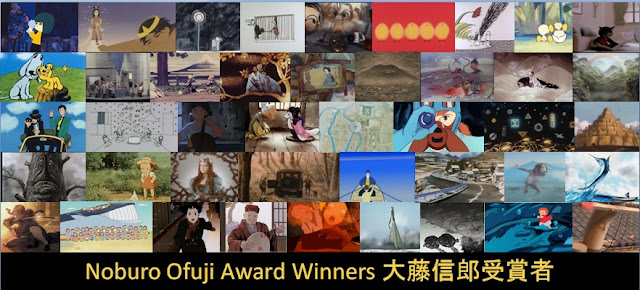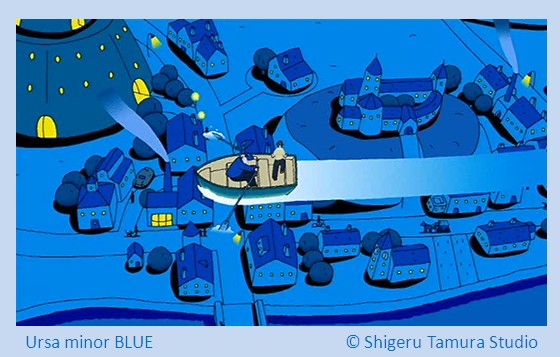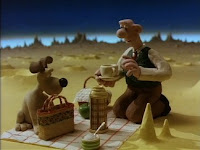The young filmmaker Takashi Iitsuka (飯塚貴士, b. 1985) wowed
Nippon Connection 2012 with the international premiere of his short film Encounters (エンカウンターズ,
2011). The half hour action adventure action figure drama has previously screened at festivals in Japan such as the Sendai Short
Film Festival and the Yubari International Fantastic Film Festival.
Encounters uses
neither stop motion animation nor any CG effects. It is purely old school live action puppet
action – a technique which Iizuka has christened “Super Organic Battle Action.” Using handmade action figures and monster
puppets, Iizuka carefully manipulates the characters either by hand or fishing wire. The result is a loving
send up of the great monster movies of Ishirō
Honda (Godzilla, King Kong vs.
Godzilla, Mothra vs. Godzilla). The
campiness of the film and the use of marionette effects recalls the “supermarionation” techniques employed
in the UK cult classic Thunderbirds (Gerry and Sylvia Anderson, 1965-6).
The story centers on two buddies,
Max and John, who have taken a trip to the countryside to help Max get his mind
off his girlfriend troubles. Just as the countryside and a chance encounter
with a friendly stray dog named Kifune seem to be lifting Max’s spirits, a
furry super-monster crashes into the scene and has a confrontation with some
armed forces. The story then spirals
into a pastiche plot line that throws in all the elements typical in a Japanese
scifi action adventure: a mad scientist, fear of robots, love and friendship
conquering all, and so on.
Talking to Iitsuka at Nippon
Connection, I discovered that he did indeed play alone with action
figures a lot as a kid. He was an only
child and did not have the means to buy too many toys. He had a hero figure in Ultraman but lacked
monsters – a problem he remedied by creating his own monsters using PET
bottles. His aim with Encounters was to transfer the fun and
spontaneity of such child’s play into the film.
His eyes lit up with delight when I
mentioned the Thunderbirds and he
added that he was also a big fan of Captain
Scarlet and the Mysterons (1967-8), a dark scifi “supermarionation” also by
Gerry and Sylvia Anderson. In terms of
action films, in addition to being inspired by the Ultraman franchise, Iitsuka is also a big fan of The Delta
Force movies starring Chuck Norris
and Lee Marvin. This would explain his choice of Waffen
Film Studio for the name of his one man production company. “Waffen” is German for “weapons”.
All levels of production were done
by Iizuka himself: cinematography, editing, sound, music, set building, costumes
and special effects. He made about 5 or
6 sets and manipulated the figures either marionette-style using fishing wire (which
you can cheesily still see in some frames) or by hand (but without the hands
being seen). For one sequence, for
example, he built the set on top of the bathtub so that he could manipulate the
figures from underneath. Some of the
figures and sets were made using materials that he already had but others were built
with supplies from the hobby shop. Some
of the most interesting designs were done using papercraft and based on
photographs Iitsuka took himself.
Iitsuka even does all the voices
including a falsetto for Max’s girlfriend in a flashback sequence. The subtitles are kind of odd – at times very
inspired – as when a wordy curse in Japanese is translated to English simply as “Jesus!” At other times the
English subs are awkward and badly spelled – but that just adds to the fun. The subtitles, which were done by Naoki
Suzuki of the Sendai Short Film Festival, complement the kitschiness of the
film and the quirkiness of the Japanese dialogue. Iitsuka
designed the dialogue as a spoof of the unusual Japanese dub s done on Hanna-Barbera cartoons like Shazzan (1967-9) and The Fantastic Four (1967-9) when they
were first imported to Japan.
See opening to Japanese dub of Shazzan here, and The Fantastic Four here:
See opening to Japanese dub of Shazzan here, and The Fantastic Four here:
The film was shot on a Sony Video
Z5J and edited using Abobe Software, Premiere, Aftereffects, etc. Iitsuka told me that he hopes that people will
get a message of hope from the film. He
is working on his next Super Organic Battle Action Adventure and was planning
to explore German hobby shops for materials after the festival. An art school grad, Iitsuka has a natural eye for framing - doubtless honed by years of TV watching. The concept could easily have turned out completely schlocky, but I found the result brilliant. I hope that Iitsuka’s Encounters obtains the cult following that it deserves, and I look
forward to seeing where his imagination takes him to next.
A 20 minute cut of the film is available on imdb (JP/EN)
Catherine Munroe Hotes 2012
You can follow Iitsuka on Twitter (JP only)A 20 minute cut of the film is available on imdb (JP/EN)

























